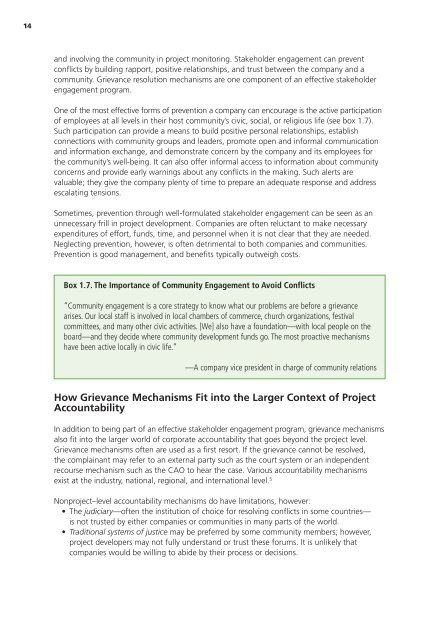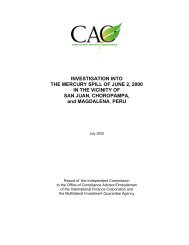A Guide to Designing and Implementing Grievance Mechanisms for ...
A Guide to Designing and Implementing Grievance Mechanisms for ...
A Guide to Designing and Implementing Grievance Mechanisms for ...
Create successful ePaper yourself
Turn your PDF publications into a flip-book with our unique Google optimized e-Paper software.
14<br />
<strong>and</strong> involving the community in project moni<strong>to</strong>ring. Stakeholder engagement can prevent<br />
conflicts by building rapport, positive relationships, <strong>and</strong> trust between the company <strong>and</strong> a<br />
community. <strong>Grievance</strong> resolution mechanisms are one component of an effective stakeholder<br />
engagement program.<br />
One of the most effective <strong>for</strong>ms of prevention a company can encourage is the active participation<br />
of employees at all levels in their host community’s civic, social, or religious life (see box 1.7).<br />
Such participation can provide a means <strong>to</strong> build positive personal relationships, establish<br />
connections with community groups <strong>and</strong> leaders, promote open <strong>and</strong> in<strong>for</strong>mal communication<br />
<strong>and</strong> in<strong>for</strong>mation exchange, <strong>and</strong> demonstrate concern by the company <strong>and</strong> its employees <strong>for</strong><br />
the community’s well-being. It can also offer in<strong>for</strong>mal access <strong>to</strong> in<strong>for</strong>mation about community<br />
concerns <strong>and</strong> provide early warnings about any conflicts in the making. Such alerts are<br />
valuable; they give the company plenty of time <strong>to</strong> prepare an adequate response <strong>and</strong> address<br />
escalating tensions.<br />
Sometimes, prevention through well-<strong>for</strong>mulated stakeholder engagement can be seen as an<br />
unnecessary frill in project development. Companies are often reluctant <strong>to</strong> make necessary<br />
expenditures of ef<strong>for</strong>t, funds, time, <strong>and</strong> personnel when it is not clear that they are needed.<br />
Neglecting prevention, however, is often detrimental <strong>to</strong> both companies <strong>and</strong> communities.<br />
Prevention is good management, <strong>and</strong> benefits typically outweigh costs.<br />
Box 1.7. The Importance of Community Engagement <strong>to</strong> Avoid Conflicts<br />
“Community engagement is a core strategy <strong>to</strong> know what our problems are be<strong>for</strong>e a grievance<br />
arises. Our local staff is involved in local chambers of commerce, church organizations, festival<br />
committees, <strong>and</strong> many other civic activities. [We] also have a foundation—with local people on the<br />
board—<strong>and</strong> they decide where community development funds go. The most proactive mechanisms<br />
have been active locally in civic life.”<br />
—A company vice president in charge of community relations<br />
How <strong>Grievance</strong> <strong>Mechanisms</strong> Fit in<strong>to</strong> the Larger Context of Project<br />
Accountability<br />
In addition <strong>to</strong> being part of an effective stakeholder engagement program, grievance mechanisms<br />
also fit in<strong>to</strong> the larger world of corporate accountability that goes beyond the project level.<br />
<strong>Grievance</strong> mechanisms often are used as a first resort. If the grievance cannot be resolved,<br />
the complainant may refer <strong>to</strong> an external party such as the court system or an independent<br />
recourse mechanism such as the CAO <strong>to</strong> hear the case. Various accountability mechanisms<br />
exist at the industry, national, regional, <strong>and</strong> international level. 5<br />
Nonproject–level accountability mechanisms do have limitations, however:<br />
• The judiciary—often the institution of choice <strong>for</strong> resolving conflicts in some countries—<br />
is not trusted by either companies or communities in many parts of the world.<br />
• Traditional systems of justice may be preferred by some community members; however,<br />
project developers may not fully underst<strong>and</strong> or trust these <strong>for</strong>ums. It is unlikely that<br />
companies would be willing <strong>to</strong> abide by their process or decisions.





